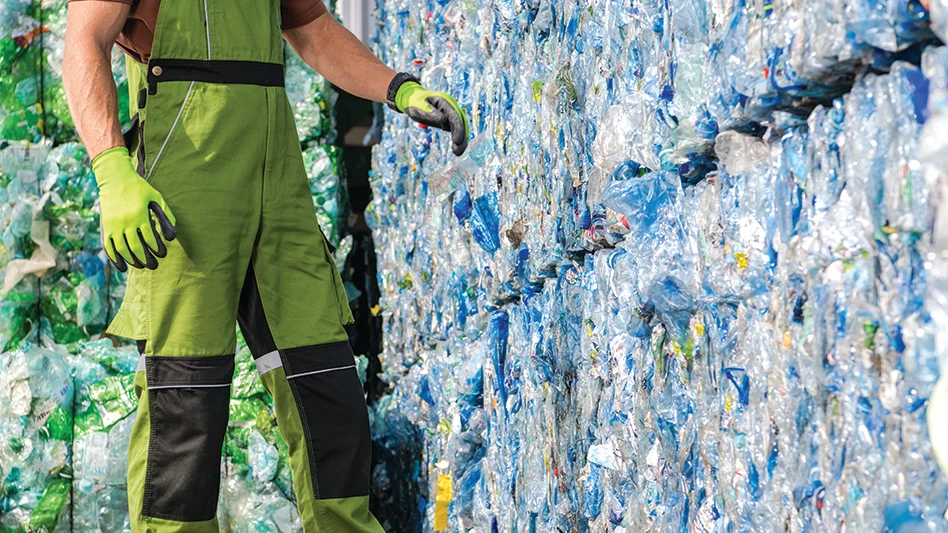
Image courtesy of Systemiq
A new study by London-based Systemiq with support from Closed Loop Partners, Eunomia Research and Consulting and The Recycling Partnership outlines a comprehensive roadmap to transition the U.S. polyethylene terephthalate (PET) packaging and polyester textile industries from the current linear single-use model towards circular, low-waste and low-emission systems by 2040.
The study, Transforming PET Packaging and Textiles in the United States, follows policy announcements that include the recent passage of the Responsible Textile Recovery Act of 2024 in California and the Executive Order on Mobilizing Federal Action on Plastic Pollution. Furthermore, Systemiq notes that extended producer responsibility (EPR) laws for packaging have been passed in five states—California, Colorado, Main, Minnesota and Oregon—and are being considered in 10 others.
According to Systemiq, PET packaging and polyester textiles, used in items like beverage bottles, food trays, apparel and carpets, are made from the same molecule, and U.S. consumers currently use more than 100 billion PET bottles and more than 10 billion polyester garments each year. The firm adds that these materials make up 30 percent of the U.S. plastic packaging and textile consumption. If current trends continue, PET/polyester consumption will grow 1.5 times by 2040, resulting in 13 million metric tons of scrap sent to landfill and incineration annually. Systemiq reports that greenhouse gas (GHG) emissions from domestic PET/polyester production would be 2.5 times higher by 2040 than levels needed to meet U.S. emissions reduction targets.
The study emphasizes the “transformative potential” of ambitious and complementary circular economy approaches—including reducing avoidable material use, scaling packaging reuse and textiles resale and expanding recycling through both mechanical and depolymerization technologies.
The study claims that by 2040, compared to a continuation of historical trends, applying these complementary measures could result in substantial environmental benefits, such as:
- an increase in recycling rates for PET packaging to 70 percent (up from 23 percent), and for polyester textiles to 19 percent (up from 1 percent);
- a reduction in virgin PET/polyester consumption and scrap sent to landfill and incineration by half; and
- a cut in projected GHG emissions for packaging by approximately 60 percent
Additionally, the study claims a transformation of the PET packaging and polyester textiles industries could create 46,000 direct U.S. jobs and generate $4.9 billion per year in revenue for U.S. recycling industries, relative to today.
“A collaborative effort across the value chain is needed to move away from our current take-make-waste system for polyester textiles and PET thermoforms and keep these valuable materials in play—rather than lose them to landfills and incineration,” says Kate Daly, managing partner at New York-based Closed Loop Partners. “Closed Loop Partners is proud to contribute to this report, which presents a clear opportunity: by adopting established circular economy solutions, we can recover billions in value, reduce waste, lower emissions and create tens of thousands of jobs in the U.S.”
The Report calls for “swift and bold” action from U.S. policymakers and industry leaders:
- Policymakers: The report says they can take decisive action by implementing well-designed EPR laws. For example, this includes encouraging product design for circularity through eco-modulation of fees, incentivizing U.S. domestic infrastructure and bottle bills where appropriate. Policymakers also can expand collection and sortation capabilities, set mandates to boost demand for postconsumer recycled content (rPET) and derisk private sector investments.
- Industry leaders: The report says they can accelerate the transformation by reducing unnecessary consumption of packaging and textiles, designing products for reuse and recycling, scaling textiles collection and increasing the use of domestically sourced rPET.
- Investors: The report emphasizes the need for collaboration between government, industry and investors to create the enabling environment, investment flows and industry adoption required to deploy new and proven technologies, such as artificial intelligence- (AI-) based material sortation and depolymerization recycling, or chemical recycling, at scale.
“The U.S. packaging and textile sectors have a real opportunity to lead the way in circular innovation,” says Brad Lich, executive vice president and chief commercial officer at Kingsport, Tennessee-based Eastman. “Eastman believes that scaling new and proven technologies like depolymerization alongside mechanical recycling and complementary circular economy approaches like reuse/refill, will reduce our dependence on fossil fuels, create jobs and significantly cut emissions.”
Kate Davenport, chief policy officer at The Recycling Partnership, Washington, says that for the U.S. to fully realize the potential of a circular economy for PET and polyester, it is vital for state and federal policymakers to implement ambitious legislation, including well-designed EPR.
“Strong public-private partnerships and clear regulatory frameworks are essential to deliver the infrastructure, attract targeted investment and scale the change required to build a better recycling system,” Davenport adds.
The report was developed under the guidance and governance of an independent steering group comprising more than 15 representatives from industry, waste management and recycling, academia and civil society, according to Systemiq. The study was commissioned and funded by Eastman, which occupied one seat on the steering group.
Latest from Recycling Today
- Orion ramping up Rocky Mountain Steel rail line
- Proposed bill would provide ‘regulatory clarity’ for chemical recycling
- Alberta Ag-Plastic pilot program continues, expands with renewed funding
- ReMA urges open intra-North American scrap trade
- Axium awarded by regional organization
- Update: China to introduce steel export quotas
- Thyssenkrupp idles capacity in Europe
- Phoenix Technologies closes Ohio rPET facility





